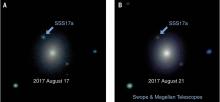
Abstract
On 17 August 2017, gravitational waves (GWs) were detected from a binary neutron star merger, GW170817, along with a coincident short gamma-ray burst, GRB 170817A. An optical transient source, Swope Supernova Survey 17a (SSS17a), was subsequently identified as the counterpart of this event. We present ultraviolet, optical, and infrared light curves of SSS17a extending from 10.9 hours to 18 days postmerger. We constrain the radioactively powered transient resulting from the ejection of neutron-rich material. The fast rise of the light curves, subsequent decay, and rapid color evolution are consistent with multiple ejecta components of differing lanthanide abundance. The late-time light curve indicates that SSS17a produced at least ~0.05 solar masses of heavy elements, demonstrating that neutron star mergers play a role in rapid neutron capture (r-process) nucleosynthesis in the universe.